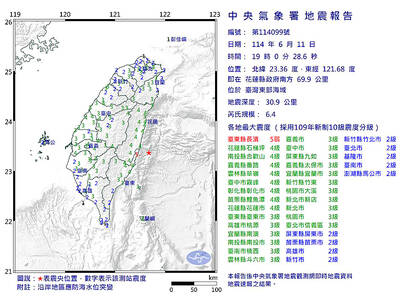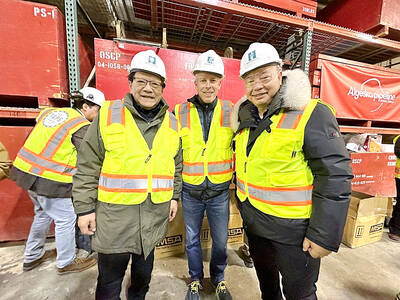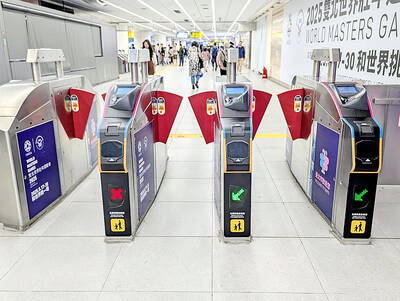The Atayal village of Smangus in Jianshi Township (尖石), Hsinchu County, began collecting an entrance fee from visitors yesterday, despite concerns raised by the government and some individuals.
“Today [yesterday] is the first day we charged the entrance fee. We had a few visitors today and they all had no problem with it,” Yuraw Icyang, a preacher at the local church, said by telephone. “The income from the entrance fee will be used to maintain and repair public facilities in Smangus, such as roads and public toilets. It will also be used to keep our village clean.”
The fee, which was agreed upon at a community meeting, is collected at a booth at the new community administration station at the entrance of Smangus. If visitors stay overnight, the fee can be deducted from lodging costs. A notice on the village’s Web site and at the entrance to the community says bicycle riders must pay NT$20, motorcyclists and scooter riders NT$30, cars NT$100 and buses NT$200.
Smangus Community Development Association secretary Lahuy Icyeh said villagers decided to charge a fee because an increased number of visitors had had a major impact on the previously isolated mountain village.
A dirt road linking Smangus to the outside world was only constructed in 1995.
The new policy drew a mixed reaction. One visitor was quoted by the Chinese-language Liberty Times (the Taipei Times’ sister paper) as questioning if the village had the legal authority to charge an entrance fee.
Visitor Joann Kuo (郭瓊恩) didn’t have a problem with it.
“I have no problem with Smangus charging visitors a fee to maintain facilities and keep it clean — I wouldn’t want to visit a place that’s poorly maintained and dirty,” she said.
Hsinchu County’s Civil Affairs Department Director Lin Ming-teh (林明德) said he was not opposed to such a policy, but it had no legal basis.
“I would see what I can do to help them [Smangus] to complete the legal process — maybe I’ll ask the [Jianshi Township] council to help out,” he said.

A magnitude 6.4 earthquake struck off the coast of Hualien County in eastern Taiwan at 7pm yesterday, the Central Weather Administration (CWA) said. The epicenter of the temblor was at sea, about 69.9km south of Hualien County Hall, at a depth of 30.9km, it said. There were no immediate reports of damage resulting from the quake. The earthquake’s intensity, which gauges the actual effect of a temblor, was highest in Taitung County’s Changbin Township (長濱), where it measured 5 on Taiwan’s seven-tier intensity scale. The quake also measured an intensity of 4 in Hualien, Nantou, Chiayi, Yunlin, Changhua and Miaoli counties, as well as

Credit departments of farmers’ and fishers’ associations blocked a total of more than NT$180 million (US$6.01 million) from being lost to scams last year, National Police Agency (NPA) data showed. The Agricultural Finance Agency (AFA) said last week that staff of farmers’ and fishers’ associations’ credit departments are required to implement fraud prevention measures when they serve clients at the counter. They would ask clients about personal financial management activities whenever they suspect there might be a fraud situation, and would immediately report the incident to local authorities, which would send police officers to the site to help, it said. NPA data showed

ENERGY RESILIENCE: Although Alaska is open for investments, Taiwan is sourcing its gas from the Middle East, and the sea routes carry risks, Ho Cheng-hui said US government officials’ high-profile reception of a Taiwanese representative at the Alaska Sustainable Energy Conference indicated the emergence of an Indo-Pacific energy resilience alliance, an academic said. Presidential Office Secretary-General Pan Men-an (潘孟安) attended the conference in Alaska on Thursday last week at the invitation of the US government. Pan visited oil and gas facilities with senior US officials, including US Secretary of the Interior Doug Burgum, US Secretary of Energy Chris Wright, Alaska Governor Mike Dunleavy and US Senator Daniel Sullivan. Pan attending the conference on behalf of President William Lai (賴清德) shows a significant elevation in diplomatic representation,

The Taipei MRT is to begin accepting mobile payment services in the fall, Taipei Rapid Transit Corp said on Saturday. When the company finishes the installation of new payment units at ticketing gates in October, MRT passengers can use credit cards, Apple Pay, Google Pay and Samsung Pay, the operator said. In addition, the MRT would also provide QR payment codes — which would be compatible with Line Pay, Jkopay, iPass Money, PXPay Plus, EasyWallet, iCash Pay, Taiwan Pay and Taishin Pay — to access the railway system. Currently, passengers can access the Taipei MRT by buying a single-journey token or using EasyCard,